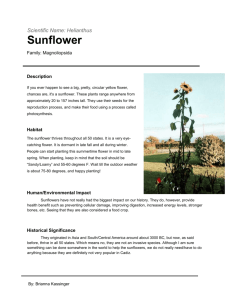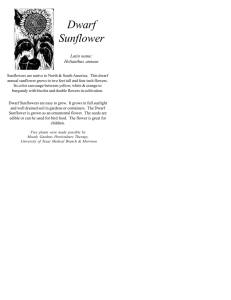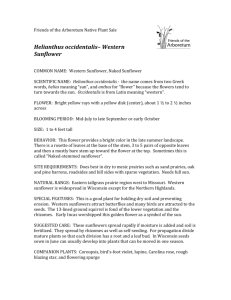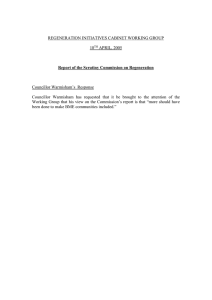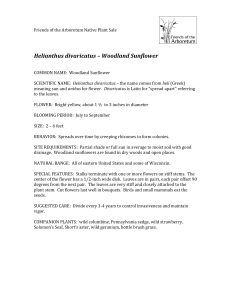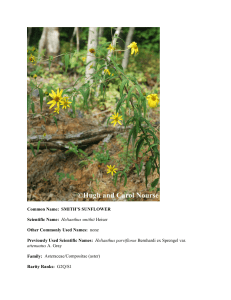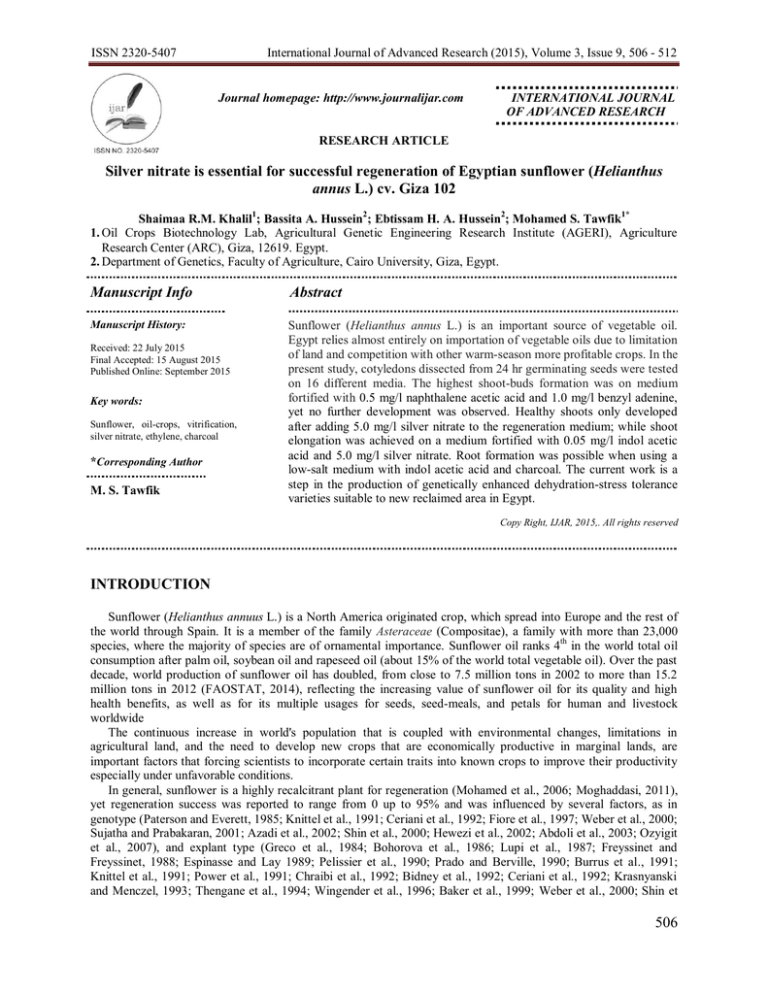
ISSN 2320-5407
International Journal of Advanced Research (2015), Volume 3, Issue 9, 506 - 512
Journal homepage: http://www.journalijar.com
INTERNATIONAL JOURNAL
OF ADVANCED RESEARCH
RESEARCH ARTICLE
Silver nitrate is essential for successful regeneration of Egyptian sunflower (Helianthus
annus L.) cv. Giza 102
Shaimaa R.M. Khalil1; Bassita A. Hussein2; Ebtissam H. A. Hussein2; Mohamed S. Tawfik1*
1. Oil Crops Biotechnology Lab, Agricultural Genetic Engineering Research Institute (AGERI), Agriculture
Research Center (ARC), Giza, 12619. Egypt.
2. Department of Genetics, Faculty of Agriculture, Cairo University, Giza, Egypt.
Manuscript Info
Abstract
Manuscript History:
Sunflower (Helianthus annus L.) is an important source of vegetable oil.
Egypt relies almost entirely on importation of vegetable oils due to limitation
of land and competition with other warm-season more profitable crops. In the
present study, cotyledons dissected from 24 hr germinating seeds were tested
on 16 different media. The highest shoot-buds formation was on medium
fortified with 0.5 mg/l naphthalene acetic acid and 1.0 mg/l benzyl adenine,
yet no further development was observed. Healthy shoots only developed
after adding 5.0 mg/l silver nitrate to the regeneration medium; while shoot
elongation was achieved on a medium fortified with 0.05 mg/l indol acetic
acid and 5.0 mg/l silver nitrate. Root formation was possible when using a
low-salt medium with indol acetic acid and charcoal. The current work is a
step in the production of genetically enhanced dehydration-stress tolerance
varieties suitable to new reclaimed area in Egypt.
Received: 22 July 2015
Final Accepted: 15 August 2015
Published Online: September 2015
Key words:
Sunflower, oil-crops, vitrification,
silver nitrate, ethylene, charcoal
*Corresponding Author
M. S. Tawfik
Copy Right, IJAR, 2015,. All rights reserved
INTRODUCTION
Sunflower (Helianthus annuus L.) is a North America originated crop, which spread into Europe and the rest of
the world through Spain. It is a member of the family Asteraceae (Compositae), a family with more than 23,000
species, where the majority of species are of ornamental importance. Sunflower oil ranks 4th in the world total oil
consumption after palm oil, soybean oil and rapeseed oil (about 15% of the world total vegetable oil). Over the past
decade, world production of sunflower oil has doubled, from close to 7.5 million tons in 2002 to more than 15.2
million tons in 2012 (FAOSTAT, 2014), reflecting the increasing value of sunflower oil for its quality and high
health benefits, as well as for its multiple usages for seeds, seed-meals, and petals for human and livestock
worldwide
The continuous increase in world's population that is coupled with environmental changes, limitations in
agricultural land, and the need to develop new crops that are economically productive in marginal lands, are
important factors that forcing scientists to incorporate certain traits into known crops to improve their productivity
especially under unfavorable conditions.
In general, sunflower is a highly recalcitrant plant for regeneration (Mohamed et al., 2006; Moghaddasi, 2011),
yet regeneration success was reported to range from 0 up to 95% and was influenced by several factors, as in
genotype (Paterson and Everett, 1985; Knittel et al., 1991; Ceriani et al., 1992; Fiore et al., 1997; Weber et al., 2000;
Sujatha and Prabakaran, 2001; Azadi et al., 2002; Shin et al., 2000; Hewezi et al., 2002; Abdoli et al., 2003; Ozyigit
et al., 2007), and explant type (Greco et al., 1984; Bohorova et al., 1986; Lupi et al., 1987; Freyssinet and
Freyssinet, 1988; Espinasse and Lay 1989; Pelissier et al., 1990; Prado and Berville, 1990; Burrus et al., 1991;
Knittel et al., 1991; Power et al., 1991; Chraibi et al., 1992; Bidney et al., 1992; Ceriani et al., 1992; Krasnyanski
and Menczel, 1993; Thengane et al., 1994; Wingender et al., 1996; Baker et al., 1999; Weber et al., 2000; Shin et
506
ISSN 2320-5407
International Journal of Advanced Research (2015), Volume 3, Issue 9, 506 - 512
al.,2000; Azadi et al., 2002; Dhaka and Kothari, 2002; Abdoli et al., 2003; Hewezi et al., 2002; Ozyigit et al., 2007;
Sujatha et al., 2012).
In Egypt, sunflower is cultivated in small area (around 60 thousand acer) and used as human snack and for birdfeeding, mainly because it is not profitable for farmers to grow compared to other summer crops. Egypt grows less
than 5.0 % of its need from vegetable oils, and depends entirely on importation of crushed oil-seeds or partially
processed oil. To our knowledge, no publication on establishment of reliable regeneration system for Egyptian
varieties has ever been attempted before. Therefore, and in an effort to establish sunflower as an oil crop in Egypt,
we investigated the possibility to establish a reliable regeneration system in sunflower cultivar Giza 102 using
cotyledons as explant source as a step on the way to genetically improve existing cultivars.
Material and Methods
Plant materials: The seeds of sunflower (Helianthus annuus L. cv. Giza 102) were kindly obtained from Field Crops
Research Institute, (FCRI), Agriculture Research Center (ARC), Giza, Egypt.
Methods: Sunflower seed germination, seeds of sunflower var. Giza 102 were surface sterilized under complete
aseptic conditions by rinsing in 70% ethanol solution for 30 sec followed by 20 min soaking in a 20% Clorox®
(commercial bleach) with two drops of Tween 20, with frequent stirring. Seeds were washed 5-6 times with sterile
distilled water to ensure the removal of disinfecting residues. Seeds were germinated for 24 hr on half strength MS
basal salt mixture medium (Murashige and Skoog, 1962), supplemented with Gamborg's B 5 vitamins (Gamborg et
al., 1968), 10.0 g/l sucrose and solidified with 6.5 g/l agar. The pH of all tissue culture media was adjusted at 5.7 and
sterilized in an autoclave at 121ºC/15 psi for 20 min.
Explant preparation: The pericarp of the overnight germinated seeds was removed using two forceps then the entire
embryo section was removed using scalpel. The two cotyledons were separated using a forceps and scalpel, each
cotyledon was divided longitudinally and placed on regeneration media.
Regeneration: Sixteen different regeneration media were tested (Table 1), media consisted of MS basal salt mixture
supplemented with Gamborg's B5 vitamins, 30.0 g/l sucrose, benzyl adenine (BA, at concentrations of 0, 0.5, 1.0 or
2.0 mg/l), naphthalene acetic acid (NAA, at concentrations of 0.0, 0.5, 1.0, or 2.0 mg/l) and 6.5 g/l agar. The
explants were placed upside down on media surface and the plates were incubated in a growth chamber at 22 ± 2 ºC
with 16/8 hr light/dark photoperiod. Each treatment had 5 replicates with a total of 50 explants per treatment; the
experiment was repeated three times. Shoots primordia were scored after 4 weeks.
Shoot development and elongation: longitudinally sectioned sunflower cotyledons, prepared as described before
were placed on nine TS7-based media supplemented with different concentration of gibberellic acid (GA3) and silver
nitrate (AgNO3) (Table 2). Each treatment consisted of 5 replicates with 50 explants. The experiment was repeated 3
times, and shoots development were observed at 23 days (Table 2). Well-developed shoot-clusters were placed on
shoot elongation medium {MS basal salt mixture supplemented with Gamborg's B 5 vitamins + 0.05 mg/l Indol
acetic acid (IAA) + 5.0 mg/l AgNO3 + 10.0 g/l sucrose and 6.5 g/l agar} for 3-4 weeks, before transferring the
shoots to rooting medium consisting of 1/2 strength MS basal salt mixture supplemented with Gamborg's B5
vitamins, 0.1 mg/l IAA, 2.0 g/l activated charcoal, 10.0 g/l sucrose and 6.5 g/l agar. Healthy plantlets with strong
rooting system were transferred into pots containing a soil mixture (clay: sand: peat moss) (1:1:1) in a Conviron ®
growth chamber at 25 ± 2˚C and 16/8hr light/dark photoperiod.
Results and Discussion
In this work, dissected cotyledons coming from 24 hrs germinated seeds were used as an explant source. Two
weeks after placing the dissected cotyledons on different media, cotyledons enlarged 4-5 times and turned green
(Figure 1a); later on we observed the beginning of callus formation which later on (3-4 weeks) started to develop
into bud clusters and shoot primordia (Figure 1b). In general, shoot clusters in all treatments (T S1 to TS16) failed to
show further development (even after placing or fresh media). We also observed that, prolonging exposure to
regeneration media led to vitrification and further callus formation (data not shown).
In general, media supplemented with 0.5 mg/l NAA (with or without cytokinin) had a higher average of shoot
primordia. The addition of 0.5 mg/l NAA caused ≥4 folds increase in total shoot primordia number compared to
media without NAA. Medium TS7 produced the highest number of shoot primordia, followed by T S6 and TS8 (47.4,
34.3 and 23.3, respectively; Table 1). Interestingly, the same range of concentration of 1.0 mg/l BA combined with
0.5 mg/l NAA was reported by other researchers to give the highest shoot regeneration (Knittel et al. 1991; Baker et
al. 1999; Ozyigit et al. 2007), indicating the importance of auxins/cytokinin balance for in sunflower regeneration.
Some researchers suggested the need for nitrogen enriched media (via the addition of 5.0 g/l KNO3) to achieve
successful shoot regeneration in sunflower (Paterson and Everett, 1985; Knittel et al., 1991; Power et al., 1991;
507
ISSN 2320-5407
International Journal of Advanced Research (2015), Volume 3, Issue 9, 506 - 512
Ceriani et al., 1992; Fiore et al., 1997; Baker et al., 1999). In the present study, we conducted some experiments and
noticed that the addition of 5.0 g/l KNO3 to regeneration medium did not result in any increase in buds formation. At
the contrary, none of these bud clusters developed into shoots, they simply started to form more callus (Data not
shown).
As mentioned earlier, shoot-bud clusters coming from different media (T S1 to TS16) failed to show any further
development, we anticipated that this problem could be a result of ethylene production inside the tissue culture
vessels; therefore we decided to conduct another set of experiments by adding AgNO 3 at different concentrations
along with GA3 using TS7-based medium (the medium with the best shoot-bud formation; Table 2). Out of the nine
different media combinations used, only medium T Sd2 (TS7 medium supplemented with 5.0 mg/l AgNO3) was
successful for the development of healthy non-vitrified shoots (Table 2; Figure 1c).
Different researchers suggested the usage of GA3 in regeneration medium to produce healthy shoots in
sunflower (Power et al., 1991; Fiore et al., 1997), and suggested that the usage of high concentration of GA 3 (0.5
mg/l or higher) resulted in production of elongated pale green shoots. In this study, GA3 addition in low
concentrations (0.0, to 0.3 mg/l) with or without the addition of AgNO 3 resulted in production of unhealthy, pale
green malformed shoots, which failed to produce roots when transferred to rooting medium (Figure 2A).
On the other hand, and in agreement with Baker (1999), the addition of AgNO3 had a dramatic impact on the
morphological characteristics of the shoots and the production of un-vitrified normal looking shoots. Although
higher concentrations of AgNO3 promoted more shoots and leaves development, yet it caused some dwarfism in
shoots. Our previous work with other oil-crops also revealed that adding AgNO3 to regeneration media had a
dramatic improvement on regeneration frequency (Al-Shafeay et al., 2011; Khalil et al., 2015).
Interestingly, the formation of vitrified or etiolated pale green shoots or shoot primordia which never
developed any further has been a well-documented problem in sunflower regeneration, a problem that different
research groups tried to solve. Some researchers suggested lowering plant hormone concentration in regeneration
media (Baker et al., 1999; Dhaka and Kothari, 2002), while others completely omitting plant hormones from media
(Shin et al. 2000; Weber et al. 2000; Azadi et al. 2002).
Clusters containing 0.5-1.0 cm long shoots, resulting from T Sd2 medium were transferred to elongation medium
for 2-3 weeks (some even started to form roots on this medium; Figure 2B), and well-elongated shoots were then
transferred to rooting medium fortified with activated charcoal (Figure 2C). The majority of shoots (more than 95%)
once placed on rooting medium were able to form rooting system.
From our previous experience with other oil crops tissue culture, we found that decreasing sucrose
concentration in rooting media, when coupled with using 1/2 strength MS salts mixture, generally results in
improvement in roots formation (Al-Shafeay et al., 2011; Khalil et al. 2015). Low concentration of IAA was used to
promote roots formation, while activated charcoal was added to further absorb any ethylene production inside the
tissue culture vessel and because it has been suggested by several research groups (Baker et al., 1999; Azadi et al.
2002). On the other hand, Fiore et al. (1997) used a mixed amino acid (glutamine, aspartic acid, L-arginine and
glycine) in addition to supplementing regeneration media with 0.2 mg/l GA3 to elongate healthy non-vitreous shoots.
Table 1. Media combination used in the establishment of regeneration system in sunflower.
Shoot formation media for sunflower (5 reps, 50 explant/treatment, repeated 3 times)
Media no.
TS1
TS2
TS3
TS4
TS5
TS6
TS7
TS8
TS9
TS10
TS11
TS12
TS13
TS14
TS15
TS16
Media composition (mg/l)
Number of shoot primordia
0.0 BA + 0.0 NAA
0.5 BA + 0.0 NAA
1.0 BA + 0.0 NAA
2.0 BA + 0.0 NAA
0.0 BA + 0.5 NAA
0.5 BA + 0.5 NAA
1.0 BA + 0.5 NAA
2.0 BA + 0.5 NAA
0.0 BA + 1.0 NAA
0.5 BA + 1.0 NAA
1.0 BA + 1.0 NAA
2.0 BA + 1.0 NAA
0.0 BA + 2.0 NAA
0.5 BA + 2.0 NAA
1.0 BA + 2.0 NAA
2.0 BA + 2.0 NAA
0.14 ± 0.14 h
2.73 ± 1.40 g
11.9 ± 1.60 e
10.1 ± 2.10 e
0.10 ± 0.10 h
34.3 ± 1.90 b
47.4 ± 6.40 a
23.3 ± 5.60 c
0.50 ± 0.50 h
18.4 ± 3.50 d
5.10 ± 2.30 f
17.0 ± 5.30 d
1.95 ± 1.70 g
11.4 ± 1.80 e
16.6 ± 2.60 d
6.90 ± 3.40 f
508
ISSN 2320-5407
International Journal of Advanced Research (2015), Volume 3, Issue 9, 506 - 512
The experiments were repeated three times, with 50 explant per treatment; numbers represents mean value
± SE; numbers followed with the same letter are non-significant at P≤ 0.05
Table 2. Media combinations used in sunflower shoot development.
Shoot development media (5 reps, 50 explant/treatment, repeated 3 times)
Media
TS7 medium + AgNO3 + GA3 (mg/l)
Shoot primordia
Well-developed shoots
TSd1
TSd2
TSd3
TSd4
TSd5
TSd6
TSd7
TSd8
TSd9
0.00 AgNO3 + 0.0 GA3
5.00 AgNO3 + 0.0 GA3
10.0 AgNO3 + 0.0 GA3
0.00 AgNO3 + 0.1 GA3
5.00 AgNO3 + 0.1 GA3
10.0 AgNO3 + 0.1 GA3
0.00 AgNO3 + 0.3 GA3
5.00 AgNO3 + 0.3 GA3
10.0 AgNO3 + 0.3 GA3
43.6 ± 6.9
39.1 ± 5.3
31.0 ± 5.9
17.0 ± 8.9
13.6 ± 6.4
25.8 ± 7.0
1.00 ± 0.0
21.5 ± 6.3
21.3 ± 1.8
1.20 ± 0.7 b c
15.0 ± 3.6 a
4.60 ± 1.6 b
1.60 ± 1.0 b c
2.40 ± 1.1 b c
3.20 ± 1.1 b
0.00 ± 0.0 c
3.50 ± 0.6 b
4.30 ± 0.5 b
The experiments were repeated three times, with 50 explant per treatment; numbers represents mean value ± SE;
numbers followed with the same letter are non-significant at P≤ 0.05
B
A
C C
D
Figure 1. Regeneration steps of sunflower (Helianthus annus L.) cv.
Giza 102. (A) 14 days old cotyledons on regeneration medium, (B)
initiation of shoot primordia 4-6 weeks post establishment of
culture without the adding AgNO3. (C) Two months old cultures
showing shoot formation on medium supplemented with AgNO3.
(D) Well-developed sunflower shoots forming roots on elongation
medium.
509
ISSN 2320-5407
A
International Journal of Advanced Research (2015), Volume 3, Issue 9, 506 - 512
B
C
Figure 2. Sample of regenerated sunflower shoots (Helianthus annus L.)
coming through tissue culture treatments. (A) Vitrified shoots growing
from shoot-clusters on media with different GA3 concentrations. (B) Welldeveloped shoots of sunflower from media supplemented with silver
nitrate. (C) normal-looking healthy sunflower shoots developing roots on
rooting medium.
Conclusion
We successfully established a regeneration protocol for Egyptian sunflower as a step required to genetically
enhance sunflower to be grown in marginal lands. We observed that NAA had a significant effect on formation of
shoot primordia, regardless of cytokinin presence or absence. Development of normal non-vitrified shoots was only
possible when adding AgNO3 to the regeneration medium. In general, ethylene is a critical factor determining the
successful regeneration of sunflower.
References
Abdoli M, Moieni A, Dehghani H 2003. Effects of genotype and cotyledon section on organogenesis in sunflower.
Iran J Biotech 1: 234–238.
Al-Shafeay AF, Ibrahim AS, Nesiem RM and Tawfik MS 2011. Establishment of regeneration and transformation
system in Egyptian sesame (Sesamum indicum L.) cv. Sohag 1. GM Crops 2(3):182-192.
Azadi P, Moieni A, Ahmadi MR 2002. Shoot organogenesis from cotyledons of sunflower. Helia 25: 19–26.
Baker CM, Fernandez NM, Carter CD 1999. Improved shoot development and rooting from mature cotyledons of
sunflower. Plant Cell Tissue Organ Cult 58: 39–49.
Bidney D, Scelonge C, Martich J, Burrus M, Sims L, Huffman G 1992. Microprojectile bombardment of plant
tissues increases transformation frequency by Agrobacterium tumefaciens. Plant Mol Biol 18: 301–313.
Bohorova NE, Cocking EC, Power JB 1986. Isolation, culture and callus regeneration of protoplasts of wild and
cultivated Helianthus species. Plant Cell Rep 5: 256–258.
Burrus M, Chanabe C, Aiibert G, Bidney D 1991. Regeneration of fertile plants from protoplasts of sunflower
(Helianthus annuus L.). Plant Cell Rep 10: 161–166.
510
ISSN 2320-5407
International Journal of Advanced Research (2015), Volume 3, Issue 9, 506 - 512
Chraibi KMB, Castelle JC, Latche A, Roustan JP, Fallot J 1992. A genotype-independent system of
regeneration from cotyledons of sunflower (Helianthus annuus L.) The role of ethylene. Plant Sci 86: 215–221.
Ceriani MF, Hopp HE, Hahne G, Escandon AS 1992. Cotyledons: an explant for routine regeneration of
sunflower plants. Plant Cell Physio 33(2): 157-164.
Dhaka N, Kothari SL 2002. Phenylacetic acid improves bud elongation and in vitro plant regeneration
efficiency in Helianthus annuus L. Plant Cell Rep 21: 29–34.
Espinasse A, Lay E 1989. Shoot regeneration of callus derived from globular to torpedo embryos from 59
sunflower genotypes. Crop Sci 29(1): 201- 205.
Fiore MC, Trabace T, Sunseri F 1997. High frequency of plant regeneration in sunflower from cotyledons via
somatic embryogenesis. Plant Cell Rep 16: 295–298.
Food and agriculture organization. http://faostat.fao.org/site/666/default.aspx.
Freyssinet M, Freyssinet G 1988. Fertile plant regeneration from sunflower (Helianthus annus L.) immature
embryos. Plant Sci 56: 177–181.
Gamborg OL, Miller, RA, Ojima, K 1968. Nutrient requirements of suspension cultures of soyabean root cells.
Exp Cell Res 50:151-158.
Greco B, Tanzarella OA, Carrozzo G, Blanco A 1984. Callus induction and shoot regeneration in sunflower
(Helianthus annus L.). Plant Sci Lett 36: 73–77.
Hewezi T, Perrault A, Alibert G, Kallerhoff J 2002. Dehydrating immature embryo split apices and rehydrating
with Agrobacterium tumefaciens : A new method for genetically transforming recalcitrant sunflower. Plant Mol
Biol Report 20: 335–345.
Khalil SRM, Hussein BA, Hussein EAH, Tawfik MS 2015. Establishment of effective regeneration system in
Egyptian-adapted canola var. pactol. J Biotech Res. 6: 35-42.
Knittel N, Escandn AS, Hahne G 1991. Plant regeneration at high frequency from mature sunflower cotyledons.
Plant Sci 73: 219– 226.
Krasnyanski S, Menczel L 1993. Somatic embryogenesis and plant regeneration from hypocotyl protoplasts of
sunflower (Helianthus annus L.). Plant Cell Rep 12: 260–263.
Lupi MC, Bennici A, Locci F, Gennai D 1987. Plantlet formation from callus and shoot-tip culture of
Helianthus annus (L.). Plant Cell Tissue Organ Cult 11: 47–55.
Moghaddasi MS 2011. Sunflower tissue culture. Adv Environ Biol 5: 746–755.
Mohamed S, Boehm R, Schnabl H 2006. Stable genetic transformation of high oleic Helianthus annuus L.
genotypes with high efficiency. Plant Sci 171: 546–554.
Murashige T, Skoog F 1962. A revised medium for rapid growth and bioassys with tobacco tissue cultures.
Physiol Plantarum 15:473-479.
Ozyigit II, Gozukirmizi N, Semiz BD 2007. Genotype dependent callus induction and shoot regeneration in
sunflower (Helianthus annuus L .). African J Biotechnol 6: 1498–1502.
Paterson KE, Everett NP 1985. Regeneration of Helianthus annus inbred plants from callus. Plant Sci 42: 125–
132.
Pelissier B, Bouchefra O, Pepin R, Freyssinet G 1990. Production of isolated somatic embryos from sunflower
thin cell layers. Plant Cell Rep 9: 47–50.
Power CJ, Boulder C, Firoozabady E, Wis M 1991. Sunflower regeneration from cotyledons. United States Pat.
5030572.
Prado E, Berville A (1990) Induction of somatic embryo development by liquid culture in sunflower
(Helianthus annuus L.). Plant Sci 67: 73–82.
511
ISSN 2320-5407
International Journal of Advanced Research (2015), Volume 3, Issue 9, 506 - 512
Shin D, Kim JS, Kim IJ, Yang J, Oh SK, Chung GC, Han K (2000) A shoot regeneration protocol effective on
diverse genotypes of sunflower (Helianthus annus L.). In Vitro Cell Dev Biol - Plant 36: 273– 278.
Sujatha M, Prabakaran AJ (2001) High frequency embryogenesis in immature zygotic embryos of sunflower.
Plant Cell Tissue Organ Cult 65: 23–29.
Sujatha M, Vijay S, Vasavi S, Sivaraj N, Rao SC (2012) Combination of thidiazuron and 2-isopentenyladenine
promotes highly efficient adventitious shoot regeneration from cotyledons of mature sunflower (Helianthus
annuus L.) seeds. Plant Cell, Tissue Organ Cult 111: 359–372.
Thengane SR, Khuspe SS, Mascarenhas AF (1994) Anther culture in Helianthus annuus L., influence of
genotype and culture conditions on embryo induction and plant regeneration. Plant Cell Rep 13: 222–226.
Weber S, Horn R, Friedt W (2000) High regeneration potential in vitro of sunflower (Helianthus annuus L .)
lines derived from interspecific hybridization. Euphytica 116: 271–280.
Wingender R, Henn HJ, Barth S, Voeste D, Machlab H, Schnabl H (1996) A regeneration protocol for
sunflower (Helianthus annuus L.) protoplasts. Plant Cell Rep 15: 742–745.
512

